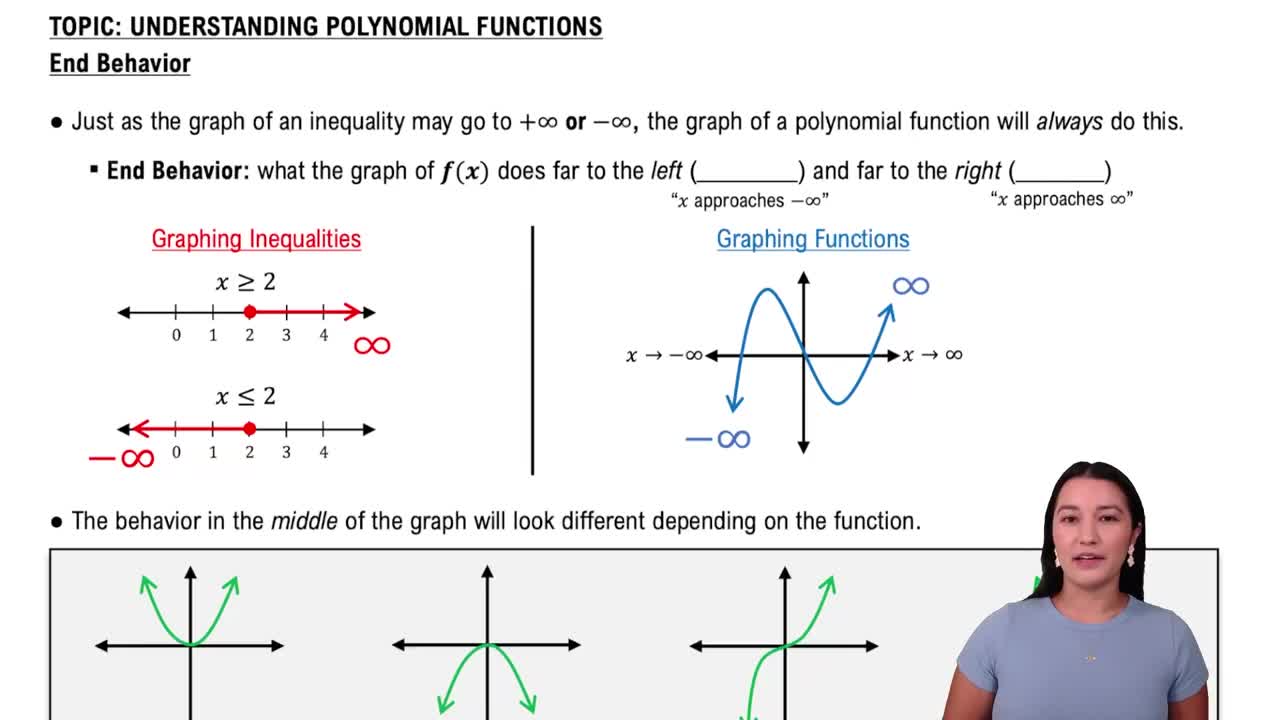Table of contents
- 0. Review of Algebra4h 16m
- 1. Equations & Inequalities3h 18m
- 2. Graphs of Equations43m
- 3. Functions2h 17m
- 4. Polynomial Functions1h 44m
- 5. Rational Functions1h 23m
- 6. Exponential & Logarithmic Functions2h 28m
- 7. Systems of Equations & Matrices4h 6m
- 8. Conic Sections2h 23m
- 9. Sequences, Series, & Induction1h 19m
- 10. Combinatorics & Probability1h 45m
3. Functions
Intro to Functions & Their Graphs
Problem 62b
Textbook Question
Determine whether each function is even, odd, or neither. See Example 5. ƒ(x)=x^4-5x+8
 Verified step by step guidance
Verified step by step guidance1
To determine if a function is even, odd, or neither, we need to analyze the function's symmetry properties.
First, recall that a function \( f(x) \) is even if \( f(-x) = f(x) \) for all \( x \) in the domain of \( f \). This means the function is symmetric with respect to the y-axis.
A function is odd if \( f(-x) = -f(x) \) for all \( x \) in the domain of \( f \). This means the function is symmetric with respect to the origin.
Let's substitute \( -x \) into the function \( f(x) = x^4 - 5x + 8 \) to find \( f(-x) \). Calculate \( f(-x) = (-x)^4 - 5(-x) + 8 \).
Simplify \( f(-x) \) to see if it equals \( f(x) \) or \(-f(x)\). If neither condition is met, the function is neither even nor odd.
Recommended similar problem, with video answer:
 Verified Solution
Verified SolutionThis video solution was recommended by our tutors as helpful for the problem above
Video duration:
1mPlay a video:
Was this helpful?
Key Concepts
Here are the essential concepts you must grasp in order to answer the question correctly.
Even Functions
A function is considered even if it satisfies the condition f(-x) = f(x) for all x in its domain. This means that the graph of the function is symmetric with respect to the y-axis. For example, the function f(x) = x^2 is even because f(-x) = (-x)^2 = x^2.
Recommended video:

Exponential Functions
Odd Functions
A function is classified as odd if it meets the condition f(-x) = -f(x) for all x in its domain. This indicates that the graph of the function is symmetric with respect to the origin. An example of an odd function is f(x) = x^3, as f(-x) = (-x)^3 = -x^3.
Recommended video:

End Behavior of Polynomial Functions
Neither Even Nor Odd Functions
A function is neither even nor odd if it does not satisfy the conditions for either classification. This means that the function's graph lacks symmetry with respect to both the y-axis and the origin. For instance, the function f(x) = x^2 + x is neither even nor odd, as it does not fulfill the criteria for either symmetry.
Recommended video:

End Behavior of Polynomial Functions

 5:2m
5:2mWatch next
Master Relations and Functions with a bite sized video explanation from Nick Kaneko
Start learningRelated Videos
Related Practice






